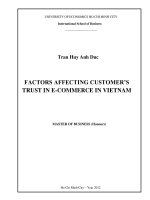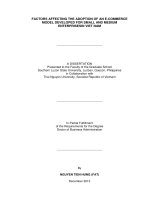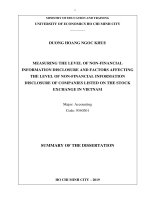factors affecting the purchasing behavior on e commerce platforms of students at fpt can tho university
Bạn đang xem bản rút gọn của tài liệu. Xem và tải ngay bản đầy đủ của tài liệu tại đây (1.89 MB, 18 trang )
<span class="text_page_counter">Trang 1</span><div class="page_container" data-page="1">
<b>RMC301-Research methods in Communication</b>
Factors affecting the purchasing behavior on e-commerce platforms ofstudents at FPT Can Tho University
<b>1.6.2. Online purchase intention...4</b>
<b>1.6.3. Online purchase behavior...4</b>
<b>1.6.4. Related theoretical models...4</b>
<b>1.7. Hypothesis...5</b>
<b>2. Research method and procedures...8</b>
<b>2.1. Data processing method...8</b>
<b>2.2. Sampling process...8</b>
<b>2.3. Method analysis...8</b>
<b>3. Data analysis and finding...8</b>
<b>3.1. Descriptive statistics...8</b>
<b>3.2. Cronbach’s alpha test...11</b>
<b>3.3. Linear regression analysis...12</b>
<b>4. Discussion...14</b>
</div><span class="text_page_counter">Trang 2</span><div class="page_container" data-page="2"><b>5.1. Conclusion...145.2. Management implications...146. References...15</b>
<b>1. Introduction1.1. Background</b>
Today, electronic commerce (e-commerce) has become a field that has an extremely importantimpact on the economic growth of countries. The development of e-commerce not only helpsfacilitate business activities but also provides many new values and meets new needs ofbusinesses and consumers. Therefore, every country in the world is interested in developing e-commerce.
According to the Ministry of Industry and Trade, e-commerce continues to be one of the brightspots in Vietnam's digital economic development, with an estimated revenue of 20.5 billion USDin 2023. Previously, if in 2018, revenue The country's retail e-commerce only reached about 8billion USD. By 2019, it had surpassed the 10 billion USD mark (reaching 10.8 billion USD) andincreased to 11.8 billion USD in 2020. By 2022 , this number increased by 20% compared to theprevious year, reaching 16.4 billion USD, accounting for 7.5% of retail revenue of consumergoods and services nationwide; The number of consumers participating in online shopping isover 54.6 million people, the online shopping value of one person reaches nearly 270 USD/year.From there, it can be affirmed that Vietnamese e-commerce has grown strongly for many yearsand is one of the pioneering fields of the digital economy, creating motivation for economicdevelopment and leading digital transformation. in business.
In fact, e-commerce sites have constantly been born and developed with 4 applications: Shopee,Lazada, Tiki, Tiktok Shop being the most popular and constantly competing with each other torise to a higher position in the field of commerce. e-commerce. Along with the popularity ofonline shopping, consumers' online purchase intention has become a topic of interest to manyresearchers in recent years (Insley & Nunan, 2014), this is shown Currently, a large number ofresearch works have been published in different fields such as information systems, marketing,management and psychology (Cheung et al., 2005; Gefen et al., 2003a; Pavlou, 2003). Results ofprevious studies also show that product characteristics influence customers' online shoppingintentions (Korgaonkar et al., 2006; Soopramanien et al., 2007). However, the results of somestudies are still inconsistent and further investigation is needed (Phau and Poon, 2000;Vijayasarathy, 2002). Although there are many studies researching the relationship betweencustomer characteristics and their online shopping intentions, however, the results of thesestudies are still not consistent, and there are still opinions. contradictory. One of the reasons forthe differences between the results of previous studies is due to cultural differences betweencountries (Chau et al., 2002; Ko et al., 2004; Park and Jun, 2003; Zhou et al., 2007). Therefore,Delafrooz et al. (2010) said that online shopping still needs to be studied more closely in specificcontexts in different countries (Delafrooz et al., 2010). On the other hand, the rapid development
</div><span class="text_page_counter">Trang 3</span><div class="page_container" data-page="3">al., 2011). Therefore, studying consumers' online shopping intentions in the specific conditionsand circumstances of Vietnam is not only meaningful in practice but also makes a theoreticalcontribution to supplement and improve the quality of online shopping. further the results ofprevious research works
Mr. Tran Van Trong, General Secretary of the E-Commerce Association (VECOM), commentedthat Vietnam is in a period of business boom through e-commerce platforms as the number ofnew online consumers continues to increase in number. , quality. "They buy more with increasedpurchase value and more sophisticated online shopping skills," he assessed. But people's buyinghabits are also gradually changing with the emergence of new shopping trends. Therefore, wedecided to choose the research topic "Factors affecting the shopping intention on e-commerceplatforms of FPT Can Tho University students".
<b>1.3. Related research documents</b>
Author Kim Hong Quan (2019) researched the topic "Factors affecting customers' onlineshopping decisions in Vietnam". The study has clarified 8 factors that influence customers'online shopping decisions in Vietnam, including: usefulness, ease of use, reliability, price, andperceived risk involved. online transactions, product-related risk awareness, customerexperience, online word of mouth. Thereby, service providers can refer to the research'srecommendations to enhance the competitiveness of their services in satisfying consumer needs.Author Phan Thanh Ha (2017) and his colleagues researched the topic of factors affectingpurchasing decisions on the Shopee trading floor of students at Ho Chi Minh City University ofTechnology. The factors included in the model are trust, price, convenience, efficiency, influencegroup, and risk. But after the research results, there are only five factors that influence thedecision to buy products through the e-commerce platform Shopee: price, convenience,efficiency, influence group, and risk.
Mohammad Hossein and colleagues (2012) researched the topic "An Analysis of FactorsAffecting on Online Shopping Behavior of Consumers". Factors included in the study by theauthor include: financial risk, product risk, website/application quality, shipping risk, impact offamily and friends, return policy, after-sales service, technology and product adoption, consumerawareness and lack of facilities for online shopping. After testing, the results showed thatfinancial risk and transportation risk have a negative impact on online consumer attitudes. Theremaining factors all have a positive influence.
<b>1.4. Research objective</b>
Overall goal:
- Determine the influence of factors on purchase intention on e-commerce platforms.- Suggest management implications for traders on e-commerce platforms.Detail goal:
- Evaluate the influence of the factors Trust, Subjective norm, Perceived usefulness andPerceived ease of use on the purchase intention on e-commerce platforms of FPT Can ThoUniversity students.
- Suggest implications for administrators so that managers of e-commerce platforms have
</div><span class="text_page_counter">Trang 4</span><div class="page_container" data-page="4">According to the World Trade Organization (WTO), adopted by the Minister of Geneva in 1998,“E-commerce includes the production, advertising, sales and distribution of products that arebought, sold and paid for. on the Internet, but delivered and received in a tangible way, bothdelivered products as well as digital information through the Internet. E-commerce is the use ofelectronic media such as the Internet to exchange, buy and sell products or services (NguyenDinh Luan, 2015). E-commerce is the buying, selling, and commercial activities that take placeon the Internet, where a customer will visit the seller's website, order and make payment for theproduct, and finally, the goods are delivered to the seller. consumers through delivery staff. E-commerce is often viewed in terms of e-business. It also includes the exchange of data thatfacilitates the financing and payment aspects of business transactions (Mesenbourg, 2000).
<b>1.6.2. Online purchase intention</b>
Alsamydai (2016) asserted that purchase intention is driven by viral advertisements related toconceptual products or services or anything else. According to Solomon (2014), intention is afactor that represents an individual's ability to perform future behavior. Therefore, Delafrooz etal. (2011) said that "online shopping intention is the consumer's ability to make purchases via theInternet". Online shopping intention will determine the customer's strength in online shoppingbehavior (Salisbury, Pearson and Miller, 2002). Pavlou (2003), when a customer intends to useonline transactions to shop, it is called online purchase intention..
<b>1.6.3. Online purchase behavior</b>
Online shopping is defined as consumer behavior in shopping through online stores or websitesusing online purchase transactions (Monsuwe et al.2004). Similarly, according to Haubl et al.(2000) online shopping is a transaction made by a consumer through a computer interface inwhich the consumer's computer is connected to the internet and can interact with the retailer'sdigital stores. retail. Online shopping persuades customers to buy products by making them feelthe benefits and enjoyment when they shop (Ha et al.2009).
<b>1.6.4. Related theoretical modelsTheory of Reasoned Action - TRA</b>
</div><span class="text_page_counter">Trang 5</span><div class="page_container" data-page="5">The theory of reasoned action model posits that behavioral intentions lead to behavior and thatintentions are determined by individual attitudes toward the behavior, along with the influence ofsubjective norms surrounding the performance of those behaviors ( Fishbein and Ajzen, 1975).Where attitude is a positive or negative attitude towards an action or behavior, which can bemeasured by beliefs (Hale, 2003). Subjective norms are an individual's perception, with thatindividual's important references, that the behavior should or should not be performed (Fishbein& Ajzen, 1975). TRA has been used by a number of authors in empirical research on consumerbehavior in the context of online shopping, such as Vijayasarathy (2002) who studied consumers'internet shopping intentions. based on TRA and adding product characteristic factors to themodel. Meanwhile, Yoh and colleagues (2003) used TRA in combination with innovationdiffusion theory (IDT) to increase the explanatory power in their research model.
<b>Technology Acceptance Model – TAM</b>
<small>Figure 2. Technology Acceptance Model – TAM</small>
The Technology Acceptance Model (TAM) is used to explain and predict technology adoptionand usage behavior. TAM is widely tested and accepted in information technology research andis considered a model with good predictive value. Accordingly, usage intention is significantlycorrelated with usage behavior, while other factors affect usage behavior indirectly throughusage intention. TAM points out that when users interact with new technology, key factors thatcan influence their decisions about using that technology include: perceived usefulness andperceived ease of use. TAM has been widely used in information systems research and it hasbeen successfully applied as a theoretical framework to predict online purchasing intentions andbehavior (Chen and Tan, 2004; Hermández and et al. 2010; Ho and Chen, 2013; Pavlou, 2003:Duong Thi Hai Phuong, 2012; Vijayasarathy, 2004). More specifically, authors have used TAMto predict online purchase intentions and behavior for products such as books (Gefen et al.,2003a: Gefen et al. 2003b: Lin, 2007), pants Austria (Ha and Stoel, 2009: Tong. 2010 ) andfinancial services (Suh and Han, 2003).
<b>1.7. Hypothesis</b>
Based on previous research and the theoretical models mentioned above, we propose factors thatinfluence purchasing intentions on e-commerce platforms of FPT Can Tho University studentsincluding: trust, subjective norms, perceived usefulness, perceived ease of use.
<b>Trust (TR)</b>
According to Wu (2015), consumer trust in e-commerce websites affects online purchasingbehavior despite the presence of risks. Sri and colleagues (2013) believe that trust in online
</div><span class="text_page_counter">Trang 6</span><div class="page_container" data-page="6">addition, trust also has a positive influence on customer satisfaction. Ngo Quoc Chien & NguyenThi Que Thanh (2017) proved that consumer trust affects customer satisfaction when shoppingonline. On the other hand, lack of trust has been noted as one of the main reasons preventingconsumers from participating in e-commerce (Jarvenpaa et al., 2000; y Monsuwé et al., 2004).Therefore, the proposed research hypothesis is:
H1: Trust has a positive impact on purchase intention on e-commerce platforms
<b>Subjective norm (SN)</b>
Research by Barkhi et al. (2008) shows that subjective norms not only have an impact oncustomers' shopping intentions but also have a significant impact on consumers' attitudes towardonline shopping. Opinions of close people such as family, friends and colleagues, celebrities...can directly or indirectly affect the trust of consumers and online suppliers through personalinformation. directly or through the mass media. Previous studies suggest that there is a positiverelationship between subjective norms and intentions (Barkhi et al., 2008; Bhattacherjee, 2000;Hansen et al., 2004; Vijayasarathy, 2004; Yoh et al., 2003 ) Therefore, hypothesis H2 isproposed:
H2: Subjective norms have a positive impact on purchase intention on e-commerce platforms
<b>Perceived usefulness (PU)</b>
What is truly useful is the degree to which customers themselves believe that using a particularsystem will improve their purchasing efficiency (Davis, 1985). Unlike traditional services, onlineservices are noticed by consumers because of their unique characteristics of being useful toconsumers. At the same time, Jarvenpaa et al. (1997) conducted a study in the United Statesshowing that convenience is a frequent cause of consumer participation in online services.Therefore, when consumers feel the usefulness of new technological services, their intention touse is greater.
H3: Perceived usefulness has a positive impact on purchase intention on e-commerceplatforms
<b>Perceived ease of use (PE)</b>
Ease of use attributes are the level at which a person believes that using a particular system willrequire no effort (Davis, 1985). Hence awareness. Usage greatly affects consumers' intention touse new technology computer services, when a computer user believes in the ability to perform atask (purchase) on a computer. The ease of use depends on the design of the computer interface,the training program on how to use the computer, the language used, and the software installedon the computer.
H4: Perceived ease of use has a positive impact on purchase intention on e-commerceplatforms
From the above four hypotheses, the model we propose is as follows:
</div><span class="text_page_counter">Trang 7</span><div class="page_container" data-page="7"><small>Figure 3. Model of factors influencing purchase intention on e-commerce platforms</small>
<b>Trust (TR)</b>
TR1 <sup>I believe that the e-commerce platform will work in</sup>
(2007), HoangQuoc Cuong
(2010)TR2 <sup>I believe that the e-commerce platform will fulfill</sup>
their commitments
TR3 <sup>I am willing to provide information to register</sup>accounts on e-commerce platforms
<b>Subjectivenorm (SN)</b>
SN1 <sup>Friends and colleagues introduced me to using </sup>commerce platforms for shopping
e-Bhattacherjee,(2000)SN2 <sup>Friends and colleagues encouraged me to use e-</sup>
commerce platforms to make purchases
SN3 <sup>Friends and colleagues often give positive reviews</sup><sub>about e-commerce platforms</sub>
Davis, Bagozzi &Warshaw (1989)PU2 I can search for all the items I need
PU3 I can shop without leaving home
<b>Perceivedease of use</b>
<b>(PE) </b>
PE1 The interface of the sales website is easy to operate
Venkatesh &Davis (2001)PE2 I easily make payments when making purchases
PE3 <sup>I can easily find information and products on </sup>commerce platforms
e-PE4 <sup>I can easily process orders on e-commerce</sup>platforms
PI1 <sup>I plan to use/continue to use the e-commerce</sup>platform to make purchases
Bagozzi,Baumgatnr & Yi
(1998)
</div><span class="text_page_counter">Trang 8</span><div class="page_container" data-page="8">for shopping
PI3 <sup>I am willing to recommend to my friends to shop</sup><sub>on the e-commerce platform</sub>
<small>Table 1. Scale of factors affecting purchasing intention on E-commerce platforms</small>
<b>2. Research method and procedures2.1. Data processing method </b>
Primary data was collected from March 9, 2024 to March 12, 2024.Secondary data was collected from relevent report.
<b>2.2. Sampling process</b>
The sample size depends on the expectation of reliability, the data analysis method, theestimation method used, and the number of parameters to be estimated in the study. According toTabachnick and Fidell (2006), to conduct regression analysis, the minimum sample size is N >8m + 50 (in which, m is the number of independent variables in the model). In this survey thereare 4 independent variables, so the minimum number of samples needed to collect is 82 samples.The results were 115 samples, in accordance with the requirements.
<b>2.3. Method analysis</b>
After collecting and eliminating unsatisfactory questionnaires, the author coded and entered thedata, then the data was processed using SPSS software. The study's data were analyzed throughthe following steps:
- Descriptive statistics: helps the researcher understand the characteristics of the survey sampleand also to consider possible relationships between variables.
- Scale reliability testing: The purpose of this test is to find out whether the observed variablesmeasure the same concept or not. The value of more or less contribution is reflected through thetotal correlation coefficient (Corrected Item - Total Correlation). Thereby, allowing inappropriatevariables to be eliminated in the research model. According to Hoang Trong and Chu NguyenMong Ngoc (2008), Cronbach's Alpha coefficient from 0.8 to nearly 1 is a good measurementscale, from 0.7 to 0.8 is usable. Cronbach's Alpha coefficient of 0.6 or higher can also beconsidered for use in new research contexts. A usable scale must have a Corregated Item – TotalCorrelation coefficient of 0.3 or higher (Hair et al., 2010).
- Multiple linear regression: The regression method used in the thesis is the OLS least squaresmethod. The adjusted R2 coefficient is used to determine the suitability of the model, the F test isused to confirm the scalability of the model, the t test is used to reject the hypothesis of theregression coefficients of the population by 0.
<b>3. Data analysis and finding 3.1. Descriptive statistics</b>
<b>Frequencies statistic</b>
</div><span class="text_page_counter">Trang 9</span><div class="page_container" data-page="9"><small>Table2. Summary table of demographic frequency statistics</small>
The survey results showed that there was no big difference between men (36.5%) and women(45.2%) in observed variables and most were final-year students (36.5%). When asked about
<b>SchoolYear</b>
</div><span class="text_page_counter">Trang 10</span><div class="page_container" data-page="10">The average monthly spending ranges from 1 million VND to 3 million VND, accounting for thehighest percentage (40%), then below 1 million VND (34.8%) and finally over 3 million VND(25.2%). ). For the multiple-choice question about items often purchased on e-commerceplatforms, respondents chose fashion as the most frequently purchased item, followed bycosmetics, then electronic devices and houseware with the same ratio. Equally, few respondentschoose to buy food on e-commerce platforms and other items. It is possible to comment andexplain the characteristics of the respondents from the perspective of them being a student, thatboth men and women tend to buy goods on e-commerce platforms with high purchasingfrequency and spending numbers. There are two items with the highest purchase rate: fashionand cosmetics, which represent the personality characteristics and interests of today's younggeneration.
<b>TR3</b> <sup>I am willing to provide information to register</sup>
<b>SN1</b> <sup>Friends and colleagues introduced me to using </sup>
<b>SN2</b> <sup>Friends and colleagues encouraged me to use </sup>
e-commerce platforms to make purchases <sup>115</sup> <sup>3.89</sup> <sup>1.041</sup>
<b>SN3</b> <sup>Friends and colleagues often give positive reviews</sup>
<b>PE1</b> <sup>The interface of the sales website is easy to</sup>
<b>PE2</b> <sup>I easily make payments when making purchases</sup> 115 4.22 .886
<b>PE3</b> <sup>I can easily find information and products on e-</sup> 115 4.24 .904
</div>








